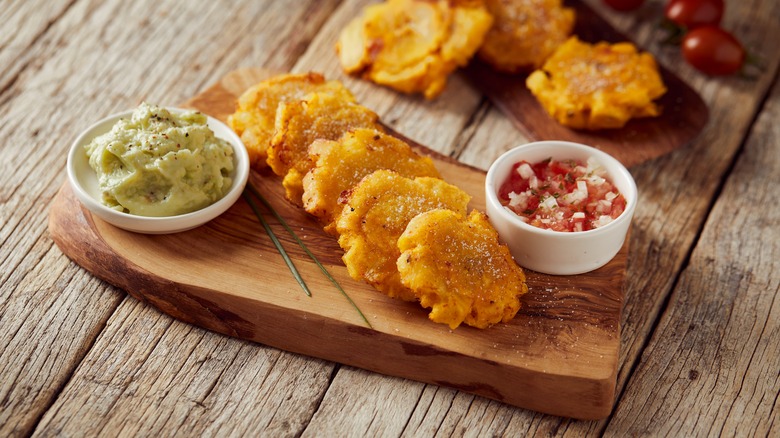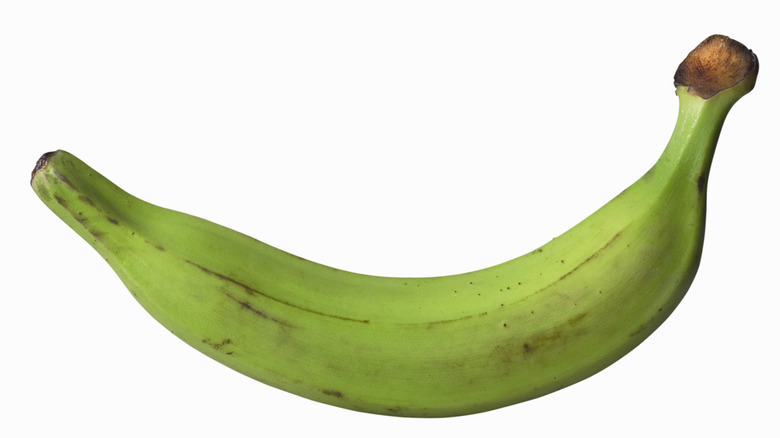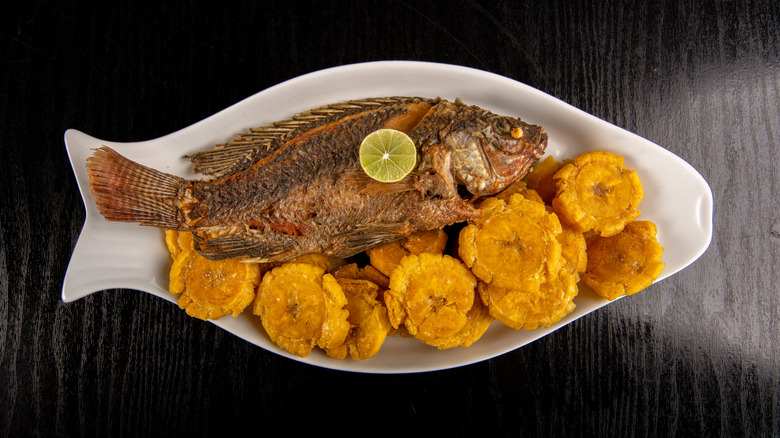Before Frying Up Tostones, Make Sure To Soak Your Plantains
Plantains can be a bit mysterious if you haven't had much experience with them. A staple food throughout the Caribbean, Central and South America, Southeast Asia, and West Africa, plantains are starchy fruits that can be eaten at any time in their ripening process, whether they are still green or ripe enough to be mottled with black spots. However, unlike other fruits, plantains do need to be cooked before they can be eaten. The greener they are, the starchier they will be, similar in taste to potatoes. As plantains ripen, they become more fruit-like with the starches sweetening and the flesh softening.
There are many ways to cook plantains, but one of the most popular is to fry them. Fried plantains can be soft and sweet or salty, paper-thin chips depending on how ripe they are and how they're prepared. Crispy, starchy tostones are made from unripe green plantains that are fried twice, once as strips and again after being mushed into discs. Ideal for dipping, they are both a common side dish and a ubiquitous snack food throughout the Caribbean and Latin America. But since the unripe plantains don't taste like much on their own, soaking the slices in salt water will help draw out their subtle flavors. Soaking green plantains can also add moisture to the naturally dry starch and help the tostones to crisp up nicely when they're fried.
When to soak green plantain slices
Making tostones can seem tricky if you don't know what you're doing. There are several steps involved, including using a double frying process. Unripened green plantains are very hard; the first round of frying softens them enough to be smashed. The first fry typically takes less than five minutes, just long enough for their color to change slightly. The plantain slices are removed from the oil and mashed into flattened disks. They're then fried a second time for another five minutes, or until they are crispy and golden.
Frying the plantains twice is only one step that shouldn't be skipped. Another is to soak your green plantains in salt water with a good squeeze of lime juice. There are two schools of thought on when to soak the plantains. The first is to soak them for at least 15 minutes right after they are sliced to help prevent any discoloration from oxidation, which is a good idea if you're not going to make your tostones right away. The other method is to soak them for approximately 10 seconds between the first and second fries. This creates steam inside the tostones that makes the inside fluffy and tender. Whether you choose to soak your tostones in salty lime water before or during the frying process, be sure to thoroughly pat them dry before dropping them into hot oil.
How to enjoy your crispy fried tostones
Crispy, fluffy, savory tostones are often eaten as a side dish at breakfast, lunch, or dinner. Their crunch works with almost any dish, from fried eggs to rice and beans, chicken and rice to fried fish to meaty stews, and they are regularly served alongside popular Puerto Rican dishes such as arroz con gandules, tripleta, and are even used as the "bread" for jibarito sandwiches.
Tostones are also beloved as a snack food, especially with dips. Guacamole, mojo verde, and various sweet and savory salsas including mango salsa and salsa rosada (mayonnaise and ketchup) are among the most popular. Since fried green plantains have such a light flavor, they go well with almost any type of dip — or eaten alone. And you don't have to worry about making too many — tostones can be refrigerated for three days or frozen for up to three months. When you're ready to finish them, just given them a good dip into salty lime water and toss them back in the frying pan to warm them up.


